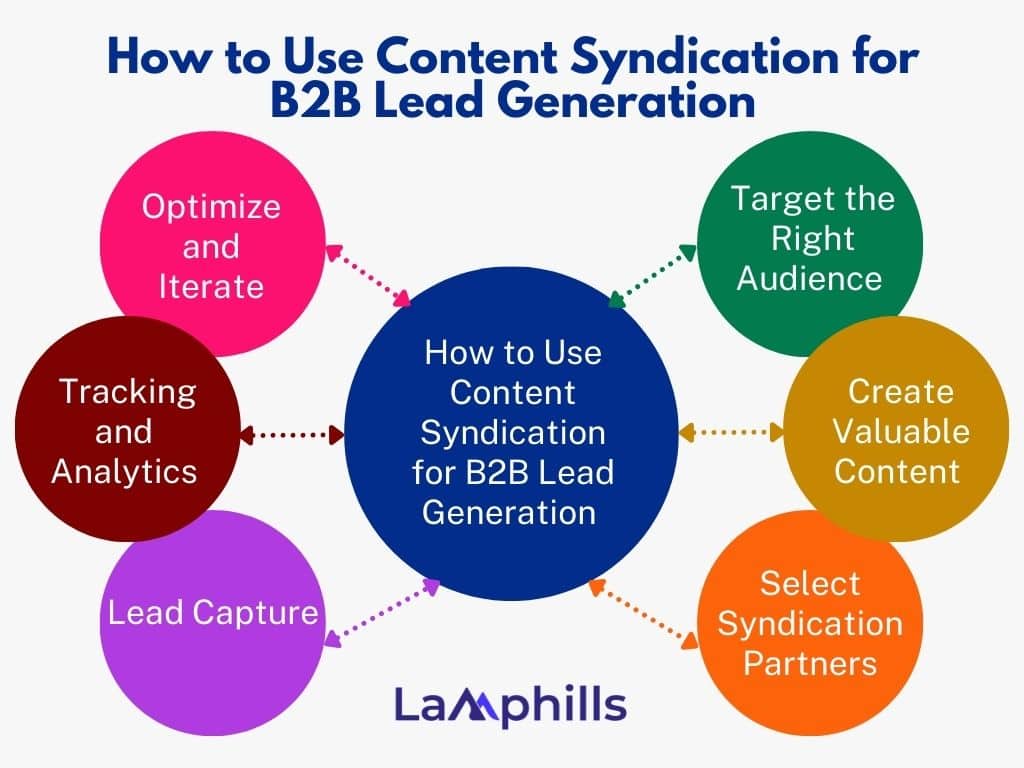If you’re in the B2B space, you’ve probably heard about content syndication but not how to make the most of it. I’ve been there. I remember my early days in B2B marketing—content syndication seemed like a mysterious art form. However, through hands-on experience and plenty of learning moments, I discovered strategies that truly work. Today, I’ll share nine practical tips from my journey and industry insights to help you supercharge your B2B marketing campaigns through content syndication.
Key Points
- Content syndication is a powerful strategy in B2B marketing that businesses adopt to extend the reach of their content beyond their channels.
- In B2B marketing, content syndication means distributing your content to third-party platforms to reach a wider audience.
- Whitepapers, case studies, infographics, research reports, webinars, and videos are some of the B2B marketing content syndication ideas you can adopt.
- To use content syndication for B2B lead generation, you must target the right audience, create valuable content, select syndication partners, and track and analyze the strategies
- LinkedIn, Outbrain/Taboola, Industry Blogs, and Email Newsletters are some of the platforms effective for enhancing your B2B content syndication.
Understanding Content Syndication in B2B Marketing
Content syndication is a powerful strategy in B2B marketing that businesses adopt to extend the reach of their content beyond their channels. This happens when B2B marketers distribute valuable content through third-party platforms to attract new audiences, generate leads, and build brand authority. In B2B marketing, content syndication is a powerful method to extend your reach and generate high-quality leads. Having leveraged this strategy extensively in my marketing campaigns, I can attest to its effectiveness in expanding audience engagement and establishing thought leadership.
What is Content Syndication in B2B Marketing?
Content syndication in B2B marketing means distributing your content to third-party platforms to reach a wider audience. From my experience, partnering with industry-specific websites and reputable platforms significantly boosts content’s visibility. However, you must ensure that the content is high-quality and relevant. Why? It builds and maintains credibility, which attracts the right audience.
How to Use Content Syndication for B2B Lead Generation

If you’re planning to use content syndication to generate leads in your B2B marketing, you need to follow the steps below:
- Target the right Audience: Clearly define who you want to reach. For instance, we segmented our audience by industry and job role. Doing this helps you focus on the people that matter and align your activities to a set goal.
- Create Valuable Content: Focus on developing high-quality, informative content after defining your audience. This can be whitepapers, webinars, and case studies that address your audience’s pain points. We found whitepapers particularly effective, generating a high number of quality leads.
- Select Syndication Partners: Having the right syndicate partners is a plus; therefore, due diligence must be applied when choosing them. Choose reputable platforms and websites that cater to your target audience. Platforms like LinkedIn, industry-specific blogs, and content aggregators can be very effective.
- Lead Capture: Regarding lead capture, we go for gated content. This enables users to provide their contact information before accessing the content.
- Tracking and Analytics: Using tools like Google Analytics, we monitored the performance and adjusted our strategies based on conversion rates and lead quality.
- Optimize and Iterate: Continuously refine your content and syndication strategy based on performance data. Experiment with different types of content and syndication partners to identify what works best for your target audience.
Types of Content Ideal for B2B Syndication
The following are some of the ideal content types that yield positive results based on our experience:
- Whitepapers
- Case Studies
- Infographics
- Webinars and Videos
- Research Reports
B2B Content Syndication Strategy
The following are the 9 best strategies I’ve used to enhance my content syndication in B2B marketing:
#1. Identify Your Target Audience
From experience, I’ll say that understanding your target audience is the foundation of any successful marketing strategy. Early in my career, I made the mistake of casting too wide a net, only to realize that specificity is key. Use tools like Google Analytics and LinkedIn Insights to gather data about your audience’s demographics, interests, and online behavior. This data will help you segment your audience and tailor your content to meet their needs and preferences. Secondly, it’ll help you identify your syndicate partners, because these are supposed to share a similar audience with you.
#2. Choose the Right Syndication Partners
Selecting the right syndication partners is key to maximizing the impact of your content. It tends to make or break your content syndication strategy. Therefore, look for partners with a strong presence in your industry. I meant those whose audience aligns with your target demographic. Evaluate potential partners based on their reach, engagement rates, and credibility. Building relationships with reputable platforms will enhance your brand’s visibility and credibility.
In my early attempts, I partnered with platforms that had large audiences but low engagement rates. It was a tough lesson, but it taught me to prioritize quality over quantity. It wasn’t until I started focusing on industry-specific platforms with engaged audiences that I saw significant results. Trust me, it’s better to reach 1,000 engaged prospects than 10,000 indifferent viewers. Here’s a piece of advice from my heart, make sure your syndicate partners align with your industry and have a proven track record of engaging your target audience. This alignment ensures your content reaches people who are genuinely interested in your offerings.
#3. Create High-Quality, Valuable Content
Creating high-quality content has always been a cornerstone of my marketing efforts. I’ve always believed that content is king, but not just any content—high-quality, valuable content. I remember a campaign where we invested time in creating a comprehensive whitepaper with actionable insights. The response was overwhelming and it generated leads for months. People crave content that solves their problems and provides value. Again, I have a little advice for you, focus on content that solves problems, answers questions, or provides real value. This can be a detailed article, insightful whitepapers, or engaging infographics. Just invest in well-researched content, because the better your content, the more likely it is to be shared and syndicated.
#4. Optimize Content for SEO
The best content can go unnoticed if it’s not optimized for search engines. SEO isn’t just a buzzword, it’s vital for making your content discoverable. I learned this lesson the hard way when my content flopped because it wasn’t optimized. When optimizing, use relevant keywords naturally within your content. Don’t forget meta descriptions, alt tags for images, and internal links. Lastly, update your content because it helps to maintain its search engine ranking and relevance.
#5. Leverage Analytics to Track Performance
Analytics tools have been game-changers for my marketing strategies. They are handy when it comes to refining your content syndication strategy. You need to track metrics like page views, time on page, and conversion rates. All these will be used to gauge the success of your content and rate its performance. These data will be used to identify what works and what doesn’t. Early in my career, I underestimated the power of data, but once I started using tools like Google Analytics and HubSpot, the insights were invaluable.
#6. Maintain Consistency Across Platforms
Consistency builds brand recognition and trust. It makes B2B marketing content syndication efforts more effective. It’s like the glue that holds things in place, therefore, maintain it in your brand voice and messaging across different platforms. You can develop a style guide that outlines your brand’s tone, voice, and messaging guidelines. This ensures that all your syndicated content, regardless of the platform, aligns with your brand identity and reinforces your message. In my experience, inconsistencies can confuse your audience and dilute your brand message. Using different styles across various platforms can confuse your audience.
#7. Use Social Media to Amplify Reach
Don’t underestimate the power of social media to get the most out of your content syndication and B2B marketing campaigns. Why? Social media can significantly amplify your content’s reach. You can tailor your posts to each platform, use relevant hashtags, and engage with your audience through comments and shares. Social media extends your content’s reach and also fosters community and interaction. Sharing syndicated content on platforms like LinkedIn, Twitter, and Facebook has always driven more traffic and engagement for me.
#8. Foster Relationships with Syndication Partners
Building strong relationships with syndication partners can enhance your efforts immensely. Why? Strong partnerships often result in more effective syndication and greater reach. You can foster genuine relationships with regular communication and high-quality content because this results in more effective syndication and greater reach. Regular communication, providing high-quality content, and seeking feedback can strengthen these relationships and enhance your syndication efforts. In a nutshell, it leads to better collaboration. Initially, I treated these partnerships as purely transactional, which was a mistake. I hope you don’t follow that path, we all want a symbiotic relationship.
#9. Continuously Update and Repurpose Content
According to Alis Behavioral Health, the average person spends 1 hour and 40 minutes on social media daily, and 75% of people hardly focus on a task without getting distracted by other things. You’ll have to contend for a fair share of people’s attention with fresh content. You can achieve this by repurposing content—like turning a detailed blog post into an engaging infographic or a video. You can also create video content since people prefer video to text. This approach keeps your content relevant and also maximizes its value and impact. I’ve recorded great success by regularly updating old content to reflect new trends and insights.
Read Also: 7 Strategies for Utilizing Brand Influencer Opportunities in 2024
Best Practices for B2B Content Syndication
Several practices yield results when it comes to B2B marketing and content syndication. All you have to do is pick what works for you but the general rules are as follows:
- Go for Quality Content: High-quality content always outperforms when it comes to engagement and lead quality. We’ve seen a direct correlation between in-depth, well-researched content and higher lead conversion rates. That’s why I’d advise anyone who wants to use content syndication for B2B marketing to prioritize well-researched, valuable content. High-quality materials consistently drive better engagement and conversions.
- Reputable Partners: Syndicating through well-regarded industry platforms can boost credibility. For example, partnerships with sites like ZDNet, and LinkedIn can provide you with a steady stream of qualified leads.
- Diverse Content Formats: Experimenting with different formats (blogs, infographics, and, videos) helped us determine which formats resonated best with our audience.
- Monitor Performance: Do not just adopt strategies, review them to be sure they’re effective. Regularly track engagement metrics, such as traffic, lead quality, and conversion rates, to assess the effectiveness of your syndication efforts.
- SEO Considerations: Avoid duplicate content penalties by using canonical tags and ensuring syndicated content links back to the original.
- Consistent Branding: Maintain your brand voice and messaging across all syndicated content to ensure brand consistency and recognition.
- Regular Updates: Keep content fresh and relevant by updating syndicated pieces, providing value, and aligning with current industry trends.
Platforms for Effective B2B Content Syndication
The following platforms will be highly effective for enhancing your B2B content syndication:
- Outbrain/Taboola
- Industry Blogs
- Email Newsletters
How Do You Measure Content Syndication Success in B2B Marketing?
It’s not enough to have the various strategies meant to enhance your B2B content syndication, are these measurable? Measurability will ensure you invest time, effort, and resources in the right practices. The following are some of the things I’ve measured in determining the success of my campaign, and I’m sure they’ll work for you too:
- Traffic: You can monitor the increase in website visits from syndicated content.
- Engagement: Aside from the traffic, the time spent on the page and bounce rates provide insights into content effectiveness. No one wants an increased bounce rate, so ensure your content is engaging.
- Lead Generation: Track the number and quality of leads. We’ve used CRM integrations to follow up and convert these leads.
- Conversion Rates: Measure how many leads turn into customers. Our analytics showed a clear link between high-engagement content and better conversion rates.
- ROI: Calculate the return on investment by comparing the revenue from syndicated content to the costs involved.
Benefits of Content Syndication for B2B Companies
The following are some of the benefits of content syndication to B2B companies:
- Increased Reach: Access to a larger audience beyond our immediate network.
- Lead Generation: Effective in attracting high-quality leads, especially when content is tailored to address specific pain points.
- Brand Authority: Publishing on reputable platforms enhanced our credibility and positioned us as industry leaders.
- SEO Advantages: Backlinks from high-authority sites improved our search engine rankings.
- Cost-Effective: We achieved significant reach with relatively low investment compared to traditional advertising.
Tips for Choosing Content Syndication Partners in B2B
The following are some things to consider when selecting content syndication partners for your B2B marketing goals:
- Audience Match: Ensure their audience aligns with your target market. We’ve seen the best results when our content was posted on sites frequented by our potential customers.
- Partner Reputation: High-credibility partners lend authority to your content. Collaborating with well-respected industry publications has significantly boosted our brand’s trustworthiness.
- Engagement Metrics: Choose partners with high user engagement. Why? High interaction rates often translate into quality leads.
- Transparency: Always prefer partners who offer clear performance metrics. This transparency helped us adjust strategies effectively.
Lamphills’ Syndication Partner Evaluation Template
Download Lamphills’ Syndication Partner Evaluation Template
How Do You Integrate Content Syndication into Your B2B Marketing Strategy?
Integrating syndication into your B2B marketing content syndication strategy involves the following:
- Alignment with Goals: This ensures your syndication efforts support your broader marketing objectives.
- Content Planning: This involves developing a content calendar and syndicating regularly to maintain audience interest.
- Strategic Partnerships: This involves selecting syndication partners that align with your target audience and industry.
- Optimization: This involves tailoring content to suit the platform and audience. For me regular updates and SEO best practices does the job.
- Lead Nurturing: Follow up the leads generated through syndication with personalized content and offers.
Common Challenges in B2B Content Syndication and Solutions
The following are some of the challenges you may face and their solutions:
- Quality Control: In all sincerity, maintaining content integrity can be difficult. To achieve this, we established strict guidelines and regularly reviewed syndicated content.
- Lead Quality: Not all leads are equal. As a result, we set clear expectations with partners and refined our targeting criteria to improve lead quality.
- SEO Issues: Duplicate content can hurt SEO. To avoid this, we use canonical tags and ensure proper backlinks to mitigate this risk.
- Content Relevance: Keeping content updated and tailored to specific audiences can maintain its relevance.
- Measuring ROI: Tracking effectiveness can be complex. We used advanced analytics tools and clearly defined metrics to evaluate success.
What is an Example of Syndicated Content?
Imagine a tech company like “Tech Innovators Inc.” publishing an in-depth guide on their blog titled “Future Trends in AI for Business.” They syndicate this article to major tech and business platforms such as TechCrunch, Forbes, and Medium. Each platform republishes the article with a note like “Originally published on Tech Innovators Inc. blog” and a link to the original post. As a result, the article gains significant visibility, drawing readers back to the company’s site for more content, thus enhancing brand awareness and driving traffic
Is Content Syndication Bad for SEO?
Not entirely. Content syndication can be beneficial for SEO if done correctly, but there are potential pitfalls to be aware of. Search engines may view syndicated content as duplicate content, which can dilute SEO efforts. To avoid this, ensure that the syndicated version of your content includes a canonical link pointing to the original article. This tells search engines which version to prioritize.
Is Content Syndication Inbound or Outbound?
Content syndication can be considered both inbound and outbound, depending on how it is used and viewed within your marketing strategy.
What is the Difference Between Content Syndication and Distribution?
Content syndication involves republishing your existing content on third-party websites to reach a wider audience, such as reposting a blog article on LinkedIn or Medium. Content distribution, on the other hand, entails sharing and promoting your content across multiple channels, including social media, email newsletters, and paid ads, like posting a blog article on Facebook, or Twitter, and sending it out via email.
Conclusion
Content syndication is a great tool in B2B marketing strategy. It begins with choosing the right partners, creating high-quality content, optimizing for SEO, leveraging analytics, maintaining consistency, using social media, fostering relationships, and continuously updating your content. These strategies, shaped by personal experience and proven industry practices, can help you elevate your B2B marketing campaigns and achieve greater success.
Related Articles
- Key Tips To A Successful Partnership Announcement (Right Way to Make a Partnership Announcement)
- STRATEGIC PUBLIC RELATIONS: Examples of Objectives With Personal Insights
- Digital PR Strategy: Ultimate Guide and Steps to Boost Your Online Presence






